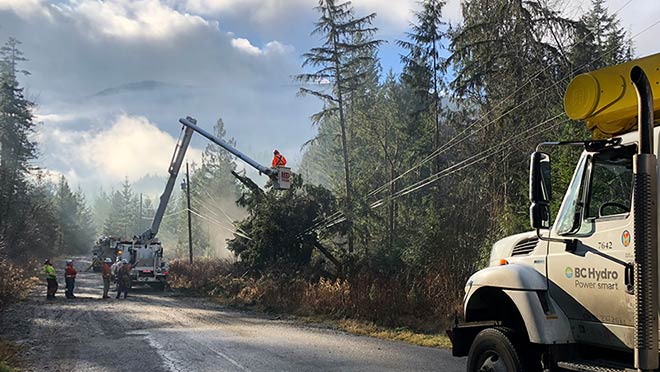It was the biggest, most damaging storm we've ever seen

Late December storm packed an unprecedented punch
On Thursday December 20, a windstorm hit the South Coast of British Columbia.
And what a storm it was.
The event would go on to become the most damaging storm we've ever experienced, affecting more customers and damaging more electrical equipment than any previous storm.
Responding to the aftermath involved the single biggest mobilization of staff, contractors and resources in our history.
A perfect storm: the weather report
This windstorm was unlike any previous event we'd encountered.
So what made this particular storm stormier?
Let's walk through some of the major contributing factors, straight from our meteorologists:
Rain
In the week leading up to the storm, we experienced some pretty substantial rainfall (400 mm in some areas to be exact) on the South Coast of the province. The heavy rains saturated the soil which reduced the stability of the trees – even the healthy ones. Trees with shallow roots, like Douglas firs and hemlocks, became more vulnerable to the heavy winds that were about to hit the area.
Wind speed
It's no surprise that the wind speeds were high. The sustained winds were generally in the range of 70-100 km/h, but in some areas topped 100 km/h. The recorded wind speeds at the Lennard Island Lighthouse, near Tofino, were as high as 144 km/h.
Wind direction
But it wasn't just wind speeds that played a role in how destructive things would be; the winds were also blowing from three different directions. In the early morning on December 20, the winds came from the southeast; by the late morning they were coming from the south, and by afternoon, prevailing winds were coming from the southwest.
The duration of these strong southwest winds was long, blowing in Duncan for more than 12 hours, and through some of the Gulf Islands for about eight hours. The southwest winds have a history of causing significant damage along the south coast of Vancouver Island, and they happen less frequently than other winds.
All these circumstances, combined with the fact that this was the first strong windstorm along the South Coast since last winter, left trees in a vulnerable and susceptible position during this storm.
The aftermath: facts and figures
When the storm hit on December 20, trees and branches came crashing down on roads and our electrical equipment across Vancouver Island, the Gulf Islands, the Lower Mainland and Fraser Valley, knocking out power to more than 750,000 customers and damaging thousands of pieces of electrical equipment.
Dealing with the aftermath required an unprecedented mobilization of resources and people.
Power outages by the numbers
- More than 750,000 customers were left without power after the windstorm including:
- 400,000 customers in the Lower Mainland and Fraser Valley
- 350,000 customers on Vancouver Island and the Gulf Islands, which represents about 80% of our customers in those regions
Damage report
- All told, the storm damaged about 3,200 pieces of electrical equipment including:
- 86,000 metres of damaged power line or 1,900 spans of wire. That's more than it would take to cover the distance between Abbotsford and Vancouver.
- 390 power poles
- 700 cross-arms
- 230 transformers
- 5,800 trouble orders were generated as a result of the storm. That's 19 times greater than the number of trouble orders we receive during an average storm. What's a trouble order? It's how work is assigned to crews so that power can be restored. These orders can range from removing a tree from a line to replacing a power pole.
Weathering the storm around-the-clock
Leading up to the storm, our team of meteorologists were closely tracking the incoming weather system, and we had crews on standby to respond. Multiple storm rooms had been established so crews could respond immediately and be moved around to restore power in the hardest hit areas.
We tapped into every available resource to support the restoration efforts.
There were more than 900 field personnel working to repair the damage and get the lights back on for our customers.We also brought in crews from the B.C. Interior, Alberta and East Coast for additional support.
Within the first 24 hours, crew restored power to over 550,000 customers – that's over 70% of our customers who were affected. However, the damage was unprecedented – especially on Vancouver Island and many of the southern Gulf Islands – which meant it took us until December 31 to restore all of our customers.
Extensive damage, challenging conditions
One of the biggest challenges was the fact that the windstorm rocked the entire South Coast, affecting four regions all at once. Typically, we're able to move crews quickly between regions so that we can get extra crews in the hardest hit areas. However, moving this many crews and bringing the trucks, heavy machinery and materials that were needed to rebuild the system over to the islands was a complex task, compared to completing the same repairs on the mainland. This was one of the reasons there were longer than average restoration times for many customers.
Repairing the damage on Vancouver Island and the Gulf Islands was particularly challenging due to access issues. On some of the southern Gulf Islands, there were trees down on 100% of the roads. That made it difficult for our crews to get around and move vehicles and equipment to where we needed to make repairs.
Crews also had to complete repairs in rural and remote areas, off the beaten path. This meant no bucket truck to support restoration efforts and instead crews had to get to sites by ATV or hike through forests on foot. The remote nature of some of the significant damage also meant that we had to get started by doing damage assessments from a helicopter or a plane; it took several days to get a full picture of the damage in many areas and what repairs would be needed.

Planning and preparing for the next storm
We're already looking ahead, reviewing our response to the storm and identifying ways we can improve. For example, some customers encountered challenges when trying to report downed lines because 9-1-1 operators in certain areas were overwhelmed with calls, while others expressed frustration when they could not find the specific status of their outage. We're looking at ways to improve both of these areas in the coming weeks.
Will you be prepared for the next one?
We want to make sure you have all the supplies and info that you need.
Have a well-stocked emergency kit including:
- First-aid kit
- Battery-powered or hand-crank radio
- Multi-function tool & knife
- Flashlight and extra batteries
- Whistle to signal for help
- Cellphone with charger
- Cash in small bills
- A local map with your family meeting place identified
- Three-day supply of food and water (for each person in your household)
- Garbage bags
- Dust mask
- Seasonal clothing and footwear
- Medications and/or eyewear prescriptions
- Manual can opener
- Extra keys, for your house and car
- Personal hygiene items
- Important family documents (i.e. copies of birth and marriage certificates, passports, licences including drivers licence, medical care card, wills, land deeds and insurance)
- A copy of your emergency plan
Stay updated: visit bchydro.com/outages on your mobile device for the most up-to-date information on an outage and estimated restoration times once available.
Follow along on our social media channels (Twitter, Facebook and Instagram) for updates during outages and emergencies. We'll post the latest information and updates that can help keep you safe and informed.












